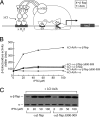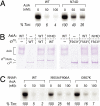The bacteriophage T4 AsiA protein contacts the beta-flap domain of RNA polymerase
- PMID: 19366670
- PMCID: PMC2672554
- DOI: 10.1073/pnas.0812832106
The bacteriophage T4 AsiA protein contacts the beta-flap domain of RNA polymerase
Abstract
To initiate transcription from specific promoters, the bacterial RNA polymerase (RNAP) core enzyme must associate with the initiation factor sigma, which contains determinants that allow sequence-specific interactions with promoter DNA. Most bacteria contain several sigma factors, each of which directs recognition of a distinct set of promoters. A large and diverse family of proteins known as "anti-sigma factors" regulates promoter utilization by targeting specific sigma factors. The founding member of this family is the AsiA protein of bacteriophage T4. AsiA specifically targets the primary sigma factor in Escherichia coli, sigma(70), and inhibits transcription from the major class of sigma(70)-dependent promoters. AsiA-dependent transcription inhibition has been attributed to a well-documented interaction between AsiA and conserved region 4 of sigma(70). Here, we establish that efficient AsiA-dependent transcription inhibition also requires direct protein-protein contact between AsiA and the RNAP core. In particular, we demonstrate that AsiA contacts the flap domain of the RNAP beta-subunit (the beta-flap). Our findings support the emerging view that the beta-flap is a target site for regulatory proteins that affect RNAP function during all stages of the transcription cycle.
Conflict of interest statement
The authors declare no conflict of interest.
Figures





Similar articles
-
Bacteriophage T4 MotA activator and the β-flap tip of RNA polymerase target the same set of σ70 carboxyl-terminal residues.J Biol Chem. 2011 Nov 11;286(45):39290-6. doi: 10.1074/jbc.M111.278762. Epub 2011 Sep 12. J Biol Chem. 2011. PMID: 21911499 Free PMC article.
-
Analysis of regions within the bacteriophage T4 AsiA protein involved in its binding to the sigma70 subunit of E. coli RNA polymerase and its role as a transcriptional inhibitor and co-activator.J Mol Biol. 2003 Jan 31;325(5):827-41. doi: 10.1016/s0022-2836(02)01307-4. J Mol Biol. 2003. PMID: 12527294
-
Mapping the molecular interface between the sigma(70) subunit of E. coli RNA polymerase and T4 AsiA.J Mol Biol. 2001 Mar 2;306(4):631-42. doi: 10.1006/jmbi.2001.4445. J Mol Biol. 2001. PMID: 11243776
-
Transcriptional takeover by sigma appropriation: remodelling of the sigma70 subunit of Escherichia coli RNA polymerase by the bacteriophage T4 activator MotA and co-activator AsiA.Microbiology (Reading). 2005 Jun;151(Pt 6):1729-1740. doi: 10.1099/mic.0.27972-0. Microbiology (Reading). 2005. PMID: 15941982 Review.
-
Transcription regulation by bacteriophage T4 AsiA.Protein Expr Purif. 2005 May;41(1):1-8. doi: 10.1016/j.pep.2004.09.019. Protein Expr Purif. 2005. PMID: 15802215 Review.
Cited by
-
Context-Dependent Action of Scc4 Reinforces Control of the Type III Secretion System.J Bacteriol. 2020 Jul 9;202(15):e00132-20. doi: 10.1128/JB.00132-20. Print 2020 Jul 9. J Bacteriol. 2020. PMID: 32424009 Free PMC article.
-
A mutation within the β subunit of Escherichia coli RNA polymerase impairs transcription from bacteriophage T4 middle promoters.J Bacteriol. 2010 Nov;192(21):5580-7. doi: 10.1128/JB.00338-10. Epub 2010 Aug 20. J Bacteriol. 2010. PMID: 20729353 Free PMC article.
-
Structural basis of σ appropriation.Nucleic Acids Res. 2019 Sep 26;47(17):9423-9432. doi: 10.1093/nar/gkz682. Nucleic Acids Res. 2019. PMID: 31392983 Free PMC article.
-
Direct activator/co-activator interaction is essential for bacteriophage T4 middle gene expression.Mol Microbiol. 2009 Nov;74(4):1018-30. doi: 10.1111/j.1365-2958.2009.06916.x. Epub 2009 Oct 15. Mol Microbiol. 2009. PMID: 19843221 Free PMC article.
-
Molecular interactions and protein-induced DNA hairpin in the transcriptional control of bacteriophage ø29 DNA.Int J Mol Sci. 2010;11(12):5129-42. doi: 10.3390/ijms11125129. Epub 2010 Dec 13. Int J Mol Sci. 2010. PMID: 21614197 Free PMC article. Review.
References
-
- Gross CA, et al. The functional and regulatory roles of sigma factors in transcription. Cold Spring Harbor Symp Quant Biol. 1998;63:141–155. - PubMed
-
- Gruber TM, Gross CA. Multiple sigma subunits and the partitioning of bacterial transcription space. Annu Rev Microbiol. 2003;57:441–466. - PubMed
-
- Keilty S, Rosenberg M. Constitutive function of a positively regulated promoter reveals new sequences essential for activity. J Biol Chem. 1987;262:6389–6395. - PubMed
-
- Murakami KS, Darst SA. Bacterial RNA polymerases: The wholo story. Curr Opin Struct Biol. 2003;13:31–39. - PubMed
Publication types
MeSH terms
Substances
Grants and funding
LinkOut - more resources
Full Text Sources
Molecular Biology Databases

